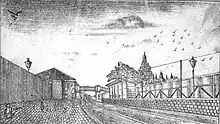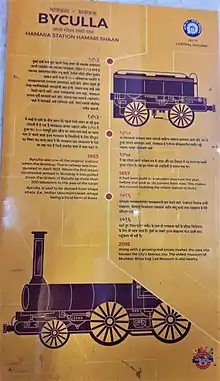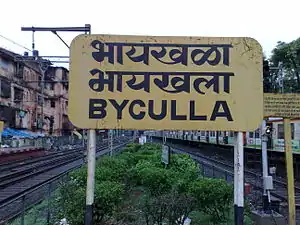Byculla railway station
Byculla (station code: BY) is railway station on the Central line of the Mumbai Suburban Railway. It is located in the neighbourhood of Byculla.
The station is a Grade-I heritage structure. The other 4 railway stations on Mumbai's heritage list include Chhatrapati Shivaji Maharaj Terminus, Western Railways Headquarters Building (Churchgate), Bandra railway station and Reay Road railway station.[1]
All the fast trains halt at Byculla station both during peak hours and normal time.
Byculla is a WiFi Station
Central Railway has install WiFi on platform 1 & 2. It has become helpful for many navigator people for navigation.

History
Byculla was one of the original stations when the Bombay–Thane railway was inaugurated in April 1853. It had been built as a wooden structure the year before, but was rebuilt in 1857 as a stone stone structure. It took on its current form in 1891.
The first locomotive was brought to Mumbai in 1852 through street of Byculla and around 200 laborers pulled it. This Locomotive, named Lord Falkland (after Bombay's then governor) was stationed on a grove near Byculla bought by the GIPR from a landlord, William Phipps at a cost of ₹4000. The engine was used for shunting operations, and had its first run from Byculla to Parel.[2]
The original Byculla station was located about 500 m south of the current station, beside where the Byculla Mankeshwar is located today. In fact the temple was mentioned by Lady Falkland, (the wife of Bombay's then governor) in her memoir of a rail journey along the line, who stated that the temple "was on verge of completion, when the line was opened."[3] The temple, which was located on the east of the former station, is also a prominent element of the station's oldest photos. Also a notable part of the old photos is a bridge on the Parell Rd, on the northern side of the station.
A picture of the station from its western platform (reproduced below) was published in the book 'Lokhandi Rastyanchey Sanchipt Varnan', A translation by Krishnashastri Bhatwadekar. The photograph shows the Mankeshwar temple on the right side. The station itself was fenced on either sides. Some buildings can also be seen on the station: one on the western side, and another on the eastern; with the former more elaborately roofed. The bridge can be seen afar, also elaborately designed, with onlookers overlooking the line from above.

The published photograph further ascertains the location of the station mentioned above. It matches both the curve of the line at the site today, and the location of the temple at the east. [4]
The station was still a small one. It only had two lines catering it, and didn't have many buildings. Still the station was fashionable among the upper class British passengers boarded from this station, as it was more elaborate than the Bori Bunder station.[5]
Byculla was also the location, where the first workshops of GIPR were opened in 1854.
The station was later Rebuilt in 1857, and then again in 1891. The station was shifted north of its old location, and a larger building was built on the site the present station stands.
Etymology
The name Byculla appears to have derived from word Bhay(Marathi:भाय = Bawa) & khala(Marathi:खळा = area to store grains), Meaning Priest's Grain storage.[6]

References
- "Mumbai Metropolitan Region – Heritage Conservation Society's Regulation Guidelines" (PDF). MMR-HCS. Retrieved 27 June 2022.
{{cite web}}: CS1 maint: url-status (link) - Aklekar, Rajendra B. (16 April 2016). "Bombay Railway & History Group: 16 points about India's first train journey -- 163 years of Indian Railways". Bombay Railway & History Group. Retrieved 14 May 2023.
- "File:Byuculla Station Banner.jpg". Wikimedia.org. 14 July 2018. Retrieved 14 July 2018.
External Links
- An Old Marathi Book on Railways from 1854, with Photographs of Bori Bunder Station and Byculla Station See pg 37, 49 respectively.


